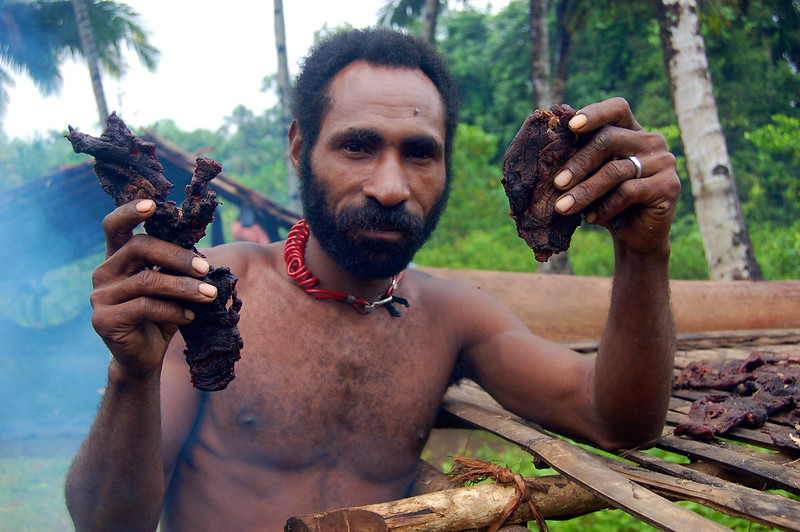Poaching for tusks, horns or other body parts is a well-recognised threat to wildlife in Africa, but the impact of hunting for bushmeat may pose a greater threat. Conservationists in Southern Africa are exploring new ways to contain this.
—
“Bushmeat is a significant problem in Zambia. For us, it’s by far the biggest threat to our wildlife populations,” Luwi Nguluka, awareness programs manager for Wildlife Crime Prevention (WCP), told Mongabay.
The Zambian NGO has been working with the country’s Department of National Parks and Wildlife (DNPW) to campaign against the supply and demand in the illegal bushmeat trade.
Nguluka says urban bushmeat consumption in Zambia is rising as populations grow and wealth increases. At the same time, Zambia’s wildlife populations are declining, making bushmeat harder to come by and so driving up the price. With increased price comes prestige, adding yet another driver to demand for the illegal meat in Lusaka, the capital.
It’s a pattern other researchers are noting elsewhere. Peter Lindsey, conservation initiatives director for the Wildlife Conservation Network, has conducted extensive research into bushmeat hunting. When he surveyed managers of protected areas, NGO staff, and tourism industry representatives about the impact of hunting for bushmeat across 11 countries in Africa, respondents ranked it as the severest threat to wildlife in protected areas, alongside hunting for body parts such as rhino horn.
Despite this, bushmeat hunting in Africa and beyond does not garner the column inches devoted to more well-known conservation issues such as the ivory trade, rhino horn or deforestation.
“We are only now beginning to appreciate that this crisis may extend to much of the Africa as a continent,” said Julia van Velden, a doctoral candidate at Brisbane’s Griffith University studying the bushmeat issue in Malawi.
You might also like: WWF Releases ‘Emergency Action Plan’ To Save Chinese White Dolphins

While the park managers and others surveyed identified hunting for bushmeat as a key threat to wildlife in Africa, there is not enough research to precisely define its impact. One worrying indicator is the many instances of otherwise healthy ecosystems where populations of large-bodied mammals are well below their expected numbers. One such example is Zambia, where populations of large mammals in national parks are 74% below their maximum carrying capacity, which researchers believe is largely a result of illegal hunting.
In West and Central Africa, where hunting and trading of many kinds of wildlife is legal or semi-legal, researchers try to extrapolate how much hunting occurs by visiting bushmeat markets, though the informal nature of the trade and the inaccessibility of some areas makes this a challenge. Estimates for the Congo Basin range from 1 million to 4 million tons of bushmeat consumed every year, with both these figures considered an underestimate by their authors. But even with some understanding of consumption, the complexity of studying forest ecosystems makes it hard to say with certainty exactly what impact bushmeat hunting is having.
The challenge becomes greater in countries where bushmeat is strictly illegal. Hunters and consumers are often understandably reluctant to divulge their activities, making it challenging for researchers to understand who is hunting what and why.
The social and economic dynamics of the bushmeat trade vary from place to place, so findings in one region are not necessarily applicable elsewhere. In many countries in Africa there is currently little or no research into the bushmeat trade, and the high cost of the research required is often beyond the means of already thinly stretched park authorities.
“Without local studies, it is impossible to manage this issue, as you simply cannot say the same drivers of these activities apply,” van Velden said.
Tackling the Supply
For communities living alongside wildlife, bushmeat can be an important component of their diet. A study tracking the availability of fish against hunting of bushmeat in nature reserves in Ghana over 30 years found that hunting increased sharply in years when fish supply was poor, suggesting an important link between bushmeat and food security.
In Madagascar, where commercial trade in bushmeat is relatively limited, hunting offers an affordable source of animal protein for rural communities. In one survey conducted in eastern Madagascar, 95% of those interviewed said they had eaten at least one protected species. But the majority showed a preference for meat from domestic animals, suggesting bushmeat hunting could be greatly reduced if alternative sources of animal protein were affordable and available.
While some hunters elsewhere on the continent still hunt purely to provide food for their families, in many places hunting wildlife has a more commercial aspect.
“It’s very rare that it’s purely subsistence,” Lindsey told Mongabay. “In some cases, guys will hunt for a bit of meat for their families but very often in that kind of arrangement, they will also sell some of the meat.”
A study of illegal bushmeat hunting in the Okavango Delta found that households that hunted typically had more wealth and cattle than those that didn’t, suggesting hunters were motivated by money rather than necessity. An unpublished study of illegal bushmeat hunting around Kafue National Park in Zambia found that virtually all hunters there were economically motivated, selling 90% of their meat and keeping 10% for their own consumption.
Communities living adjacent to national parks in Africa are often some of the most economically deprived, hampered by a lack of infrastructure and with already limited economic options often exacerbated by restrictive conservation measures. The appeal of illegal hunting is easy to see for Zambia’s poachers when each can earn a median income of $48 a month in an area where the median household income is just $15 a month.
“In most parts of Africa, mechanisms to benefit communities from wildlife are not really there,” Lindsey said, “so they take the only benefit that is available to them, which is to hunt for the pot or hunt to sell.”
Lindsey says that finding ways for local communities to benefit from wildlife is crucial to reducing hunting. One solution would be to give local communities ownership over local wildlife with an allowable quota for hunting. Local communities could choose to sell their quota to trophy hunters for greater economic return than selling bushmeat, as in Namibia’s community conservancies.
The quota system is not without its own issues, though. Lindsey points out that managing quotas in a wild ecosystem, where populations are affected by ecological conditions such as droughts, is challenging and requires constant monitoring.
Of course, benefits to local communities don’t have to be consumptive. Namibia’s community conservancy model also generates income from ecotourism and photographic safaris.
“In Namibia, in the community conservancies, there is pretty clear evidence that these methods have resulted in recovery of wildlife populations in some areas,” Lindsey said.
In a 2018 survey of rural residents in 32 of Namibia’s communal conservancies, 90% said they were happy with trophy hunting on conservancy land due to the benefits it generates for the communities. Only 11% of respondents said they supported conserving wildlife on community lands if the benefits from hunting no longer existed. An economic analysis of 77 Namibian conservancies published in Conservation Biology, found that Namibia’s complementary mix of both ecotourism and hunting was crucial to maximizing returns for local communities, and that a singular focus on either would greatly reduce the value of Namibia’s wildlife to local people.
In Lindsey’s survey of protected area managers, Namibia notably bucks the trend with bushmeat hunting of low concern relative to other threats, including poaching wildlife for body parts such as ivory, human-wildlife conflict, and incursions by livestock into protected areas.
Community-based initiatives like Namibia’s conservancies are challenging to implement. They require an identifiable local community group with exclusive and legally enforceable ownership of land — something that does not always exist. The revenue generated from activities like ecotourism and trophy hunting is also seldom enough to support a whole community, or else the benefits are unevenly distributed.
And successful community conservation initiatives like Namibia’s still require costly protection.
“Even if you had a protected area with the local community on side, there’s still a huge resource that someone is going to come and try and harvest if you don’t protect it,” Lindsey said.


















